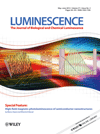
LUMINESCENCE
Scope & Guideline
Exploring the Depths of Light and Science
Introduction
Aims and Scopes
- Luminescent Materials Development:
Research on the synthesis, characterization, and enhancement of luminescent materials, including phosphors, quantum dots, and carbon dots, aimed at improving their optical properties for various applications. - Biosensing Techniques:
Innovative approaches to develop luminescent probes and sensors for the sensitive detection of biological and environmental analytes, utilizing fluorescence, chemiluminescence, and electrochemiluminescence. - Photonic Applications:
Exploration of luminescent materials in photonic devices, including LEDs, solar cells, and display technologies, focusing on their efficiency and stability. - Environmental Remediation:
Utilization of luminescent materials in photocatalytic processes to degrade pollutants and in sensing applications for environmental monitoring. - Bioluminescence Studies:
Research into natural bioluminescent systems, their mechanisms, and potential applications in biosensing and imaging.
Trending and Emerging
- Green and Sustainable Chemistry:
A growing emphasis on eco-friendly synthesis methods for luminescent materials, including the use of natural resources and waste products, aligns with global sustainability goals. - Advanced Nanomaterials:
Research on nanostructured luminescent materials, including nanocomposites and hybrid systems, is trending, showcasing their potential in various applications from sensing to biomedical uses. - Smart and Multifunctional Sensors:
There is an increasing focus on developing luminescent sensors that integrate multiple functionalities, such as environmental monitoring, medical diagnostics, and food safety. - Biotechnology and Bioimaging:
The application of luminescent materials in biotechnological contexts, particularly for bioimaging and drug delivery, is emerging as a significant area of development. - Mechanoluminescence and Photonic Devices:
Research into mechanisms of luminescence triggered by mechanical stress and the development of photonic devices utilizing these principles is gaining traction.
Declining or Waning
- Traditional Spectroscopic Methods:
There has been a noticeable decrease in papers relying solely on traditional spectroscopic methods for luminescence analysis, as newer, more sensitive, and efficient techniques are being adopted. - Generalized Environmental Studies:
Research focusing on broad environmental studies without specific luminescent applications appears to be waning, as the journal shifts towards more targeted and innovative applications. - Conventional Luminescent Sensors:
The exploration of conventional luminescent sensors that do not incorporate advanced materials or novel strategies is declining, with a preference for more sophisticated and multifunctional sensing approaches.
Similar Journals
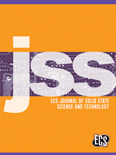
ECS Journal of Solid State Science and Technology
Exploring Innovations in Electronic, Optical, and Magnetic MaterialsECS Journal of Solid State Science and Technology, published by the Electrochemical Society, is a prominent journal dedicated to the advancement of research in the field of electronic, optical, and magnetic materials. With an ISSN of 2162-8769 and an E-ISSN of 2162-8777, this journal has established a significant presence since its inception in 2012, spanning critical developments in solid-state science that are essential for innovative technologies. Operating within the United States and recognized for its global outreach, it holds a respectable Q3 category ranking in the materials science category as of 2023, reflecting its commitment to high-quality research and its role in bridging theoretical and applied aspects of materials science. Researchers, professionals, and students alike will find vital information and cutting-edge studies that further the understanding and applications of solid-state technologies. The journal is accessible to an extensive audience, making it an invaluable resource for those engaged in the ever-evolving landscape of materials science.

PHYSICS OF THE SOLID STATE
Driving Insights in Contemporary Scientific ChallengesPhysics of the Solid State is a distinguished journal published by Pleiades Publishing Inc., focusing on the rapid advancements and fundamental research in the realms of condensed matter physics, electronic, optical, and magnetic materials. With an ISSN of 1063-7834 and an E-ISSN of 1090-6460, this journal serves as a crucial platform for disseminating high-quality research findings, insights, and reviews essential for both academic and industrial professionals in the field. As of 2023, its Scopus ranking places it in the 26th percentile for both Condensed Matter Physics and Electronic, Optical and Magnetic Materials, reflecting its evolving influence and contribution to the scientific community. Although currently classified in the Q4 quartile, the journal aims to foster interdisciplinary dialogue, improve research visibility, and enhance its impact on contemporary scientific challenges through rigorous peer-reviewed articles and focused special issues. Despite its traditional model of access, it continues to play a pivotal role in engaging researchers and fostering innovation in solid-state physics.
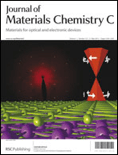
Journal of Materials Chemistry C
Unlocking the Potential of Advanced MaterialsJournal of Materials Chemistry C, published by the renowned Royal Society of Chemistry, is a leading academic journal focusing on innovative research in the field of materials chemistry. With an impressive impact factor, this journal has solidified its status as a top-tier publication within its field, ranking in the Q1 category for both Chemistry (miscellaneous) and Materials Chemistry as of 2023. Positioned at the forefront of -materials science, it serves as a vital platform for researchers, professionals, and students to disseminate findings that highlight the synthesis, characterization, and application of advanced materials. The journal's open access model allows for broader readership and engagement, ensuring that groundbreaking research is accessible to a global audience. As a result, the Journal of Materials Chemistry C plays a crucial role in advancing the understanding and technology of materials, fostering collaboration and innovation within this dynamic scientific community.

JOURNAL OF OPTOELECTRONICS AND ADVANCED MATERIALS
Fostering Collaboration in Cutting-Edge ResearchJOURNAL OF OPTOELECTRONICS AND ADVANCED MATERIALS, published by the NATL INST OPTOELECTRONICS in Romania, is an esteemed academic journal dedicated to disseminating innovative research in the fields of optoelectronics and advanced materials. With an ISSN of 1454-4164 and E-ISSN 1841-7132, the journal provides a platform for researchers to share their findings and technological advancements from 1999 to 2024. Despite being placed in the Q4 quartile across several categories—including Atomic and Molecular Physics, Condensed Matter Physics, and Electrical and Electronic Engineering—the journal serves as an essential resource for highlighting significant developments in its respective fields. Researchers and professionals may find valuable insights that foster collaboration and inspire further investigation, thereby contributing to the continuous evolution of optoelectronics and materials science.
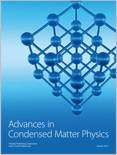
Advances in Condensed Matter Physics
Fostering Collaboration in Cutting-Edge PhysicsAdvances in Condensed Matter Physics is a distinguished journal published by HINDAWI LTD, dedicated to the rapid dissemination of high-quality research in the field of condensed matter physics. Since its inception in 2008, this Open Access journal has facilitated wide accessibility to cutting-edge findings and theoretical advancements, with aims to foster collaboration and innovation within the scientific community. With an ISSN of 1687-8108 and an E-ISSN of 1687-8124, the journal covers an extensive range of topics, from quantum materials to nanotechnology, ensuring relevance and engagement across various sub-disciplines. As a testament to its impact in the field, it is ranked in the Q3 category for 2023 within Scopus and holds a position in the 34th percentile for physics and astronomy. The journal's continuous commitment to publishing significant exploratory research until 2024 makes it a pivotal resource for researchers, professionals, and students eager to stay on the leading edge of condensed matter physics advancements.

FULLERENES NANOTUBES AND CARBON NANOSTRUCTURES
Connecting Researchers to the Cutting Edge of Carbon ScienceFULLERENES NANOTUBES AND CARBON NANOSTRUCTURES, published by Taylor & Francis Inc, stands at the forefront of research in the fields of nanotechnology, materials science, and organic chemistry. With an ISSN of 1536-383X and an E-ISSN of 1536-4046, this journal offers a critical platform for disseminating significant findings related to carbon-based nanostructures, materials characterization, and their innovative applications. Recognized for its scholarly impact, the journal enjoys a Q2 ranking in several fields, including Atomic and Molecular Physics, Materials Science, and Organic Chemistry, reflecting its commitment to quality research. Since its inception in 2002, it has maintained a rigorous publication standard and provides open access options, enabling a diverse audience, from researchers to industry professionals, to engage with the latest advancements. The journal's comprehensive scope across converged years until 2024 emphasizes its pivotal role in fostering knowledge in the rapidly evolving realm of nanoscience and nanotechnology. Researchers and practitioners alike are encouraged to explore the cutting-edge research showcased in this vital resource.
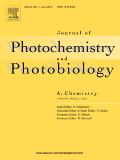
JOURNAL OF PHOTOCHEMISTRY AND PHOTOBIOLOGY A-CHEMISTRY
Shining a Light on Innovative Chemical DiscoveriesJOURNAL OF PHOTOCHEMISTRY AND PHOTOBIOLOGY A-CHEMISTRY is a prestigious peer-reviewed journal published by Elsevier Science SA, focusing on the interdisciplinary fields of photochemistry and photobiology. Established in 1987 and set to span to 2025, the journal has earned a notable reputation, currently ranking in the Q2 quartile in Chemical Engineering, Chemistry, and Physics & Astronomy, as per the 2023 metrics. With an impressive Scopus ranking, including #34 in General Physics and Astronomy and #50 in General Chemical Engineering, it represents a significant platform for researchers aiming to contribute to advancements in these critical areas. While the journal operates under a subscription model, it remains accessible through various academic databases, ensuring that cutting-edge research reaches a global audience. Researchers, professionals, and students are encouraged to explore the latest studies and reviews that explore the interactions of light with chemical processes and biological systems, positioning the journal as essential reading for anyone in the field.

SEMICONDUCTORS
Pioneering insights in condensed matter physics.SEMICONDUCTORS, published by PLEIADES PUBLISHING INC, is a prominent journal that provides a platform for researchers and professionals in the fields of Atomic and Molecular Physics, Condensed Matter Physics, and Electronic, Optical and Magnetic Materials. With an ISSN of 1063-7826 and an E-ISSN of 1090-6479, the journal has been diligently disseminating knowledge since its inception in 1996 and continues to pave the way for innovative research until 2024. Although currently unclassified in the Open Access model, its influence is underscored by its rankings in Scopus, where it ranks in the 21st-22nd percentile across critical scientific categories. SEMICONDUCTORS serves as an essential resource for cutting-edge research, fostering a greater understanding of semiconductor materials and their applications, thereby assisting the scientific community in pushing the boundaries of technology and innovation.

Methods and Applications in Fluorescence
Driving Collaboration in Fluorescence ApplicationsMethods and Applications in Fluorescence is a premier academic journal published by IOP Publishing Ltd, dedicated to the interdisciplinary study of fluorescence techniques and their applications across various scientific fields. With a distinguished impact factor and categorized in the Q2 quartile for 2023 in multiple domains including Atomic and Molecular Physics, Optics, Instrumentation, and Materials Science, this journal plays a crucial role in advancing research and innovation in the field. The journal's scope encompasses a rich array of methodologies and applied studies, fostering collaboration between researchers and professionals aiming to push the boundaries of fluorescence sciences. With its commitment to rigorous peer review and open dissemination of knowledge, Methods and Applications in Fluorescence is essential for anyone involved in fluorescence-related research or applications, offering insightful contributions that drive the field forward. The journal is accessible to academics from around the globe, ensuring dissemination of valuable findings and methodologies from 2013 to 2024 and beyond.

ChemPhotoChem
Pioneering Insights in Chemistry and Materials ScienceChemPhotoChem is a premier journal published by WILEY-V C H VERLAG GMBH based in Germany, dedicated to advancing the fields of chemistry and materials science through innovative research on photochemical processes. With an impressive Q1 ranking in the categories of Analytical Chemistry, Organic Chemistry, and Physical and Theoretical Chemistry as of 2023, this journal serves as a vital platform for researchers and professionals seeking to disseminate groundbreaking findings within these critical domains. Though not an open-access publication, ChemPhotoChem ensures comprehensive accessibility via subscription models, thus providing robust support to the academic community. With its inception in 2017 and continuing through 2024, the journal fosters interdisciplinary collaboration and promotes high-quality scholarship that addresses both fundamental and applied aspects of photochemistry. Whether you're a seasoned researcher or an emerging scholar, ChemPhotoChem stands as an essential resource for understanding the transformative impact of light on chemical processes.